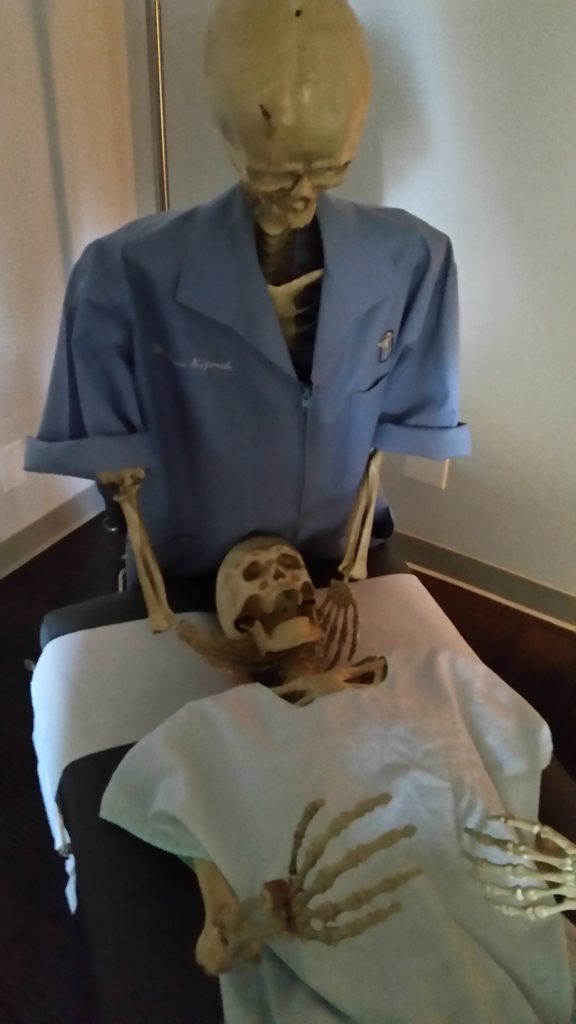Without digging too deep…
- We’ve Got Your Back at First Chiropractic
- No Skeletons in Our Closet…Just In Our Waiting Room
- We Make No Bones About It … Only Adjustments!
Happy Halloween from Dr. Sam & Team First Chiropractic

|
 |
 |
 |
Gilroy Chiropractic Clinic & Massage Therapy
Posted in: Tips |
Without digging too deep…

|
 |
 |
 |
Manuka Honey is a darker than most types of honey you may be accustomed to…and it’s specifically collected from bees that have been feasting on the Manuka tree, found primarily in New Zealand and southeast Australia.
A new study at the University of Southampton in the U.K. recently reported that the honey from Down Under may be useful for decreasing the risk of infections and helping to prevent pathogenic bacterial colonies known as biofilm from developing on catheters and other medical devices.
Indwelling medical devices harbor biofilms which have been shown to cause infections and act as reservoirs for pathogens. Urinary catheters are often in place for considerable periods of time and are susceptible to both encrustation and biofilm formation…Strategies for minimizing biofilm occurrence underpin an active research area in biomedicine. Manuka honey has, (among other things), well-established antibacterial properties.”1 ~ The Journal of Pathology
The study entailed placing Manuka honey with bacterial cultures including Escherichia coli (E. coli), the cause of up to 90 percent of urinary tract infections (UTIs),2 and Proteus mirabilis, bacteria that under certain conditions can escape from the intestine and cause a urinary tract infection,3 to observe the honey’s effect on biofilm development. Medical News Today reported:
After 72 hours, the team found the highest dilution of honey — 16.7 percent — had reduced the stickiness of bacteria by 77 percent, and all other dilutions had reduced stickiness by at least 70 percent by that point.
Scientists still want to conduct further testing, however, before they advise using honey on catheters in real hospital settings, but as a Time article noted:
Antibiotic resistance is a major problem worldwide. Bacteria can naturally become resistant to drugs used to treat it, and widespread use of antibiotics through the years in medicine and agriculture have contributed to the problem. 5
They say that doing the same thing over and over and expecting a different result is the definition of insanity, yet doctors keep applying and prescribing the same ineffective methods and drugs to and for their patients with UTIs and other health problems, often making their diseases, pain and suffering worse. And all the time, honey was right under their noses.
Posted in: Tips |
Since Chiropractic is a profession with a wide variety of practice philosophies and techniques, selecting the best chiropractor for your needs can be challenging. By it’s unique nature, chiropractic treatment is a physical procedure…and new patients should give consideration comfort levels as to doctor-patient rapport as well as the doctor’s joint manipulation style compatibility.
Knowing exactly what your Insurance Covers is a basic first step in this process. It’s a practical matter to receive the most possible from your insurance benefits while paying the least out-of-pocket for your care. If choosing a chiropractor who participates in your plan is vital to your situation, then put it at the top of your list. That said…you should still consider credentials and experience as highly important criteria in your decision process.
1. Check Referrals – Ask family, friends and other healthcare providers for recommendations. Take the time to research the chiropractors’ credentials and experience on the more substantial Online Reviews sites like Google, Bing, Wellness and Healthgrades. Reading the thoughts and responses from patient experiences can provide insight into how the chiropractor provides care, as well as how his or her practice is operated. Give a quick call each Chiropractor’s office to verify whether they are even accepting new patients. If they are, schedule an appointment to meet the chiropractor in person for a consultation.
2. Research the Chiropractor’s Credentials – Verifying that your prospective Chiropractor is indeed properly licensed is a minimum preliminary step in your research. It signifies that the chiropractor has the necessary training, skills and experience to provide chiropractic care. Confirming the absence of any malpractice claims or disciplinary actions is also part of this step. Usually you can find a chiropractor’s medical training and certifications and other history on state licensing websites.
3. Chiropractor’s Experience Level – Experience is always important…especially in the case of musculoskeletal or spine health issues. The more experience a chiropractor has with a condition or procedure, the better your results are likely to be. Ask how many patients with your specific condition the chiropractor has treated. If you need a specific procedure, ask how many of the procedures the chiropractor has performed and find out about complication rates—complications the chiropractor has encountered as well as your own risk of complications.
4. Gender Preference – Being comfortable with openly discussing personal information is critical…so if your Chiropractor’s gender helps, factor it into your decision process. Chiropractors are becoming more skilled in caring for women and men differently. Ask the chiropractor about his or her recent training and experience specifically related to your condition and your gender.
5. Communication Style Compatibility – When you first meet the chiropractor, ask a thoughtful question that’s pertinent to your situation…and consider they respond. Do you feel your questions are welcomed? …and answer them in ways that you can understand? Find a chiropractor who shows an interest in getting to know you, who will consider your treatment preferences, and who will respect your decision-making process.
Read More on Choosing a Chiropractor
Posted in: Tips |
Yes, we are in the process of creating a FANTASTIC new web presence!
But, otherwise…it’s business as usual.
Please Call for appointments:
Need Directions? See Contact Us!